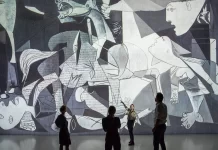Pablo Picasso, born on October 25, 1881, in Málaga, Spain, and passing away on April 8, 1973, in Mougins, France, was one of the most influential and celebrated artists of the 20th century. His artistic journey spanned over seven decades, during which he produced an astonishingly diverse body of work that forever changed the landscape of modern art.
Picasso’s artistic career can be divided into several distinct periods, each marked by a unique style and artistic exploration:
- Early Years (Blue Period and Rose Period): Picasso’s early works were characterized by a somber, melancholic palette during the “Blue Period” (1901-1904), reflecting themes of poverty and human suffering. This was followed by the more cheerful “Rose Period” (1904-1906), where he introduced warmer colors and themes of circus performers and acrobats.
- Cubism: Perhaps the most revolutionary of Picasso’s phases, Cubism (1907-1921) broke down objects and figures into geometric shapes, shattering traditional notions of perspective and representation. Along with Georges Braque, Picasso co-founded this movement, which included both Analytic and Synthetic Cubism. His work “Les Demoiselles d’Avignon” is often considered the starting point of this movement.
- Surrealism: In the 1920s, Picasso briefly explored Surrealism, a movement that sought to express the irrational and unconscious mind. His paintings during this period, such as “The Weeping Woman” (1937), often featured distorted and fragmented figures.
- Neoclassicism: During the 1920s and 1930s, Picasso shifted towards a more classical style, drawing inspiration from ancient Greek and Roman art. This phase produced works like “The Pipes of Pan” (1923) and “The Dream” (1932).
- Later Years: Picasso’s later years were marked by a return to more experimental and varied styles. He continued to produce art prolifically, exploring various mediums like ceramics and sculpture. His “Dove of Peace” (1949) became an enduring symbol of hope and peace.
Throughout his career, Picasso’s art was not limited to painting alone; he also excelled in sculpture, ceramics, printmaking, and even stage design. His innovative approach to materials and techniques redefined the boundaries of artistic expression.
Picasso’s influence on the art world cannot be overstated. He challenged conventional norms, constantly reinventing himself and the art he created. His work not only influenced countless artists but also had a profound impact on the development of modern art movements such as Abstract Expressionism and Pop Art.

Beyond his artistic contributions, Picasso’s life and persona have also become legendary. He lived a bohemian lifestyle, surrounded by a circle of creative and intellectual luminaries of his time. His passion for art, innovation, and unrelenting creativity have left an indelible mark on the art world, making him a towering figure in the history of modern art.
School of the Art, Tira
History of Modern Art
Art Education
















